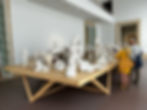"What you are regarding as a gift is a problem for you to solve" - Galleria Nazionale d'Arte Moderna e Contemporanea
- Madeleina Kay
- Apr 16, 2024
- 4 min read
Photos and reflections from Rome National Gallery of Modern and Contemporary Art.

When the building looks like this from the outside - you expect to be impressed by the inside...

I found the display of older "modern" paintings in the main hall to be interesting - they'd clearly crammed them all in - a kind of "get it over and done" with approach which meant that, although the display was impressive, it was impossible to see the higher paintings in any detail. There were also no legends to tell you title, artists or dates. Personally, I am not a massive enthusiast of paintings from this period (they bore me a bit), but I do find it interesting to examine the brushstrokes / technique used to create the image - which of course, isn't possible if the paintings are way above eye level.
For example, I really liked the portraits of Boldini (created in the late 19th century), because of the dynamic brush strokes and gestural linework he used. The technique added significant interest to what would otherwise be a pretty tedious image.

I was rather amused by the invigilator's chairs which were very similar to one of the artworks on display - which was created from burnt celophane.
There were a lot of BIG NAME artists included in the exhibition; Pollock, Miro, Kandinsky, Monet, Magritte, Rodin, Kapoor etc. I honestly wasn't that impressed by any of these artworks (with the exception of Klimt) - it felt like they were only included because of their "brand" recognition.
Particularly this painting 'Le Paysage en Feu' (1920) by Magritte - it's just bad.

Klimt, on the other hand, I will always love. And having seen the infamous 'The Kiss' at the Leopold gallery in Vienna, I was delighted to see 'The Three Ages of Woman' - which I actually preferred. There is a breath-taking amount of emotion encapsulated in this image. which is also compositionally beautiful.

A close up inspection of the hands, shows the talent in Klimt's technique. It's quite obvious to see where Egon Schiele (one of my favourite artists) learned his skill from.

I was also delighted to see the Dadaist urinal, 'Fountain' by Marcel Duchamp in real life. Arguably one of the most pivotal artworks in the history of modern art - it felt somewhat like going to Mecca.

I was grateful to discover plenty of new artists whilst wandering the exhibition, including the Greek artist, Jannis Kounellis. This 'Untitled' artwork, was particularly powerful, and made me pause for thought. There was so much power and violence embedded in the viual language; simple forms and colour palette, that seemed somehow utterly tragic.

I loved this modern take on Monet's water lillies, which were boldly displayed opposite an original.

Similarly, I loved this incredible wall-hanging, by Ghanaian artist, El anatsui, made from recycled metal - which had the texture of chain mail.

This artwork, which was displayed without a legend, seemed particularly pretinent to me. A glass panel with the text, 'What you are regarding as a gift is a problem for you to solve - Wittgenstein', made me instantly think of the video of the burning gift I made a few weeks ago. It was a much classier commentary than mine, which provoked self-reflection (literally and metaphorically). It also made me contemplate the nature of being gifted or having 'talent' - which sometimes seems like it could be more of a burden than a cause for celebration.

I also found an artwork, 'Mappa' by Alighiero Boetti, which seemed particularly relevant to my MA research into flags and symbols of national identity. An embroidered tapestry of a map of the world where the countries are coloured with their national flags. It was immediately obvious that this artwork was out-dated because of the presence of the Soviet Union, which was dissolved in December 1991 - the artwork was from 1990. I was also interested to see the old South African flag (which was replaced in 1994 by the current flag) - which featured the Union Jack, a representation of our colonial influence. I need to do some more research on this artist.

My favourite artwork in the whole exhibition was this green number which was presented in a custom 3-D frame. The artwork was presented without a plaque, but Google reverse image search helped me identify the information; 'The Arrows of Life', c.1920 (oil on canvas) by Giacomo Balla. I loved the dynamic, intersecting lines, the colour composition and the curious repurposing of imagery; the ruler appearing in a snake-like fashion amidst the vegetation. The frame was also very impactful, with it's wooden lettering - I wish I could understand.

In a similar manner to the main hall full of older artworks, there was a room where a plethora of small, traditional sculptures had been dumped on a table with hand-written tags. I've noticed it's become quite trendy to present traditional sculpture in this "store room" style - I've visited a few exhibitions where they're presented still in their packaging crates. I think it's a rather desperate attempt to make them more interesting to a contemporary audience.

The final room I visited before leaving the museum, was what I called "the War Room". Which featured large-scale gruesome paintings depicting various conflicts and a series of dog sculptures which were savaging each other or lying (presumably deceased) on the ground. There was also a video projected on a wall, which featured a soundtrack of explosions and gun fire. I found it a bit traumatic and upsetting to be in that space and didn't think it was the best note to end on... But perhaps it is a poignant reminder of the Roman history of conquest.
























